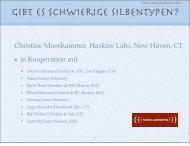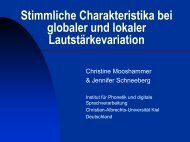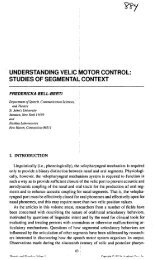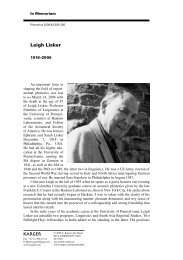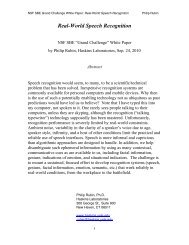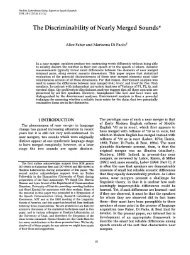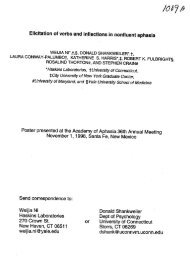Reception of Language in Broca's Aphasia* - Haskins Laboratories
Reception of Language in Broca's Aphasia* - Haskins Laboratories
Reception of Language in Broca's Aphasia* - Haskins Laboratories
You also want an ePaper? Increase the reach of your titles
YUMPU automatically turns print PDFs into web optimized ePapers that Google loves.
125<br />
to be associated is generally assumed to be costly <strong>of</strong> memory resources (e.g., Wanner &<br />
Maratsos, 1978). This is consistent with the claim that the parser works most<br />
efficiently when it can form constituents locally. on a word by word basis.<br />
Evidence <strong>of</strong> on-l<strong>in</strong>e process<strong>in</strong>g is also provided by many detection experiments which<br />
f<strong>in</strong>d that the identification <strong>of</strong> a target segment-a specific phoneme, letter, or word-is<br />
faster as a sentence progresses. We call this the word position effect. 3 The word position<br />
effect probably reflects the normal on-l<strong>in</strong>e operation <strong>of</strong> the pars<strong>in</strong>g mechanism. In the<br />
course <strong>of</strong> pars<strong>in</strong>g, the perceptual process<strong>in</strong>g system assigns structure to a sentence<br />
without wait<strong>in</strong>g until all its words or constituents have arrived, allow<strong>in</strong>g lower level<br />
<strong>in</strong>formation to be rapidly segmented and shunted upward through the system. This<br />
enables the processor to work on several levels <strong>in</strong> parallel with<strong>in</strong> a narrow "w<strong>in</strong>dow" <strong>of</strong><br />
only a few words (e.g., Frazier & Fodor, 1978; Marcus, 1980). Later items are detected<br />
faster because assignment <strong>of</strong> a structural analysis reduces the number <strong>of</strong> subsequent<br />
structural options that otherwise·. would be pursued. This, <strong>in</strong> tum, frees up<br />
computational resources needed for other process<strong>in</strong>g tasks. S<strong>in</strong>ce <strong>in</strong>formation <strong>in</strong><br />
verbal work<strong>in</strong>g memory can be stored only briefly before it decays (Baddeley & Hitch.<br />
1974; Conrad, 1964), the availability <strong>of</strong> a mechanism for the rapid on-l<strong>in</strong>e <strong>in</strong>tegration<br />
<strong>of</strong> <strong>in</strong>com<strong>in</strong>g <strong>in</strong>formation is essential for the <strong>in</strong>terpretation <strong>of</strong> extended speech or text.<br />
It is surpris<strong>in</strong>g, <strong>in</strong> view <strong>of</strong> the <strong>in</strong>terest the question has generated, that the available<br />
data on comprehension <strong>in</strong> agrammatism leaves open the question <strong>of</strong> how well<br />
agrammatics can process items <strong>in</strong> the closed-class vocabulary <strong>in</strong> tasks that tap normal<br />
(on-l<strong>in</strong>e) sentence pars<strong>in</strong>g operations. The experiment <strong>of</strong> L<strong>in</strong>ebarger et al. (l983a) was<br />
not designed to assess the on-l<strong>in</strong>e process<strong>in</strong>g capabilities <strong>of</strong> their subjects. Nonetheless.<br />
any attempt to dismiss the grammaticality judgment task on a priori grounds is<br />
unwarranted, s<strong>in</strong>ce even post Iwe judgments could <strong>in</strong> pr<strong>in</strong>ciple reflect structural<br />
analyses computed by the subject on l<strong>in</strong>e. The purpose <strong>of</strong> the present <strong>in</strong>vestigation was<br />
to study the question <strong>of</strong> whether agrammatic and normal speakers use implicit<br />
knowledge <strong>of</strong>closed-class words <strong>in</strong> the same way. both <strong>in</strong> comput<strong>in</strong>g syntactic structure<br />
for a given <strong>in</strong>put str<strong>in</strong>g and <strong>in</strong> mak<strong>in</strong>g on-l<strong>in</strong>e decisions about grammaticality. In<br />
design<strong>in</strong>g the stimulus materials and procedure, we have been m<strong>in</strong>dful <strong>of</strong> the criticisms<br />
raised by Zurtf and Grodz<strong>in</strong>sky because much rides on the correct <strong>in</strong>terpretation <strong>of</strong> the<br />
L<strong>in</strong>ebarger et al. (1983a) f<strong>in</strong>d<strong>in</strong>gs.<br />
The present experiment satisfies the criterion <strong>of</strong> naturalness <strong>in</strong> so far as it was<br />
designed to reveal whether agrammatics assign syntactic structure on l<strong>in</strong>e. We<br />
developed a chronometric technique to test the speed and accuracy with which normal<br />
control subjects and aphasics can detect grammatical errors <strong>in</strong> sentences <strong>in</strong> which<br />
grammaticality turns on the use <strong>of</strong> a closed-class vocabulary item. The technique<br />
converts the ord<strong>in</strong>ary grammaticality judgment task <strong>in</strong>to one that taps on-l<strong>in</strong>e<br />
process<strong>in</strong>g: It achieves this, first, by present<strong>in</strong>g each sentence only once at a normal<br />
conversational rate; second, by emphaSiz<strong>in</strong>g speed <strong>of</strong> decision, requir<strong>in</strong>g a response as<br />
soon as the violation is detected, thus allOW<strong>in</strong>g little opportunity for reflection; and,<br />
third, by controll<strong>in</strong>g the location <strong>of</strong> the word that normal subjects would identify as the<br />
source <strong>of</strong> ungrammaticality <strong>of</strong> each test sentence.<br />
The chief goal <strong>of</strong> this <strong>in</strong>vestigation was to discover whether the receptive language<br />
impairment commonly associated with "agrammatic" production results from<br />
impaired grammatical knowledge <strong>in</strong>volv<strong>in</strong>g the closed class morphology or whether<br />
the impairment is caused by a process<strong>in</strong>g difficulty. This question is framed aga<strong>in</strong>st a<br />
backdrop <strong>of</strong> syntactic theory-as well as a current proposal concern<strong>in</strong>g the nature <strong>of</strong><br />
l<strong>in</strong>guistic process<strong>in</strong>g (e.g., the Modularity Hypothesis <strong>of</strong> Forster. 1979, and Fodor,<br />
1983).4 With<strong>in</strong> the framework <strong>of</strong> Government-B<strong>in</strong>d<strong>in</strong>g theory (Chomsky. 1981),<br />
Grodz<strong>in</strong>sky (1984a) has proposed that the tendency <strong>of</strong> some aphasics to omit closedclass<br />
items <strong>in</strong> production, as well as their failures to <strong>in</strong>terpret them correctly, is due to a<br />
<strong>Reception</strong> <strong>in</strong> <strong>Language</strong> <strong>in</strong> <strong>Broca's</strong> Aphasia




